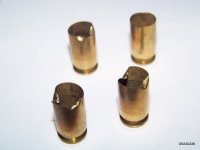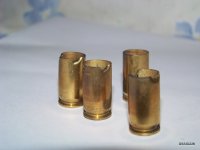Those are caused by the slide striking the cases on closing before they clear the ejection port. This is actually more likely a load/ejector/recoil spring combination problem than an extractor problem, but a mis-tensioned extractor can contribute to it.
The easiest way to correct extractor tension is with a
Weigand gauge from Brownells that works together with a trigger weight scale. It is sold as a set that covers 9mm Luger through .45 ACP for $15.
It has to be kept in mind the standard 1911 is designed for full power ammunition with bullets 200 grains and up. It was also designed for the military, who don't care what condition the brass is left in, so even the full power stuff is often dented after leaving a military 1911. As soon as you shoot reduced power loads or start using bullets lighter than 200 grains, more brass damage can occur.
There are several things you can do about this. The Colt Goldcup and most modern 1911 clones have the ejection Port lowered at its bottom edge and an angled radius thinning cut called a rollover notch is put on at the back edge of the port. In combination with a reduced power recoil spring, these help lower power target loads clear the ejection port. You may already have these feature on your gun. Your photos look like the leading edge of a roll over notch may be what hit the edges of the case mouths, but I can't be certain without handling one.
Some kinds of spring-loaded recoil buffers cause the slide to slam back forward prematurely. If you have one installed, try removing it.
Another fix (my first move in this situation) is to install a Commander length ejector in place of the standard 1911 ejector. The Commander has a shorter slide stroke than the full size 1911, and to get brass clear of the ejection port before the slide starts to close on it requires the ejection be timed to begin a little earlier in the extraction. So, the Commander ejector has a nose that sticks out a little further than a standard ejector does, and the case head runs into it sooner as the extractor pulls it back. If you make this change it is often helpful to angle the ejector nose a little to give the case the best trajectory out of the ejection port. A picture of that is below, with an as-purchased Commander length ejector on the left and one with a modified nose one on the right. Again, Brownells has the Commander length ejectors (they call them
Extended Ejectors), though there are other sources.




